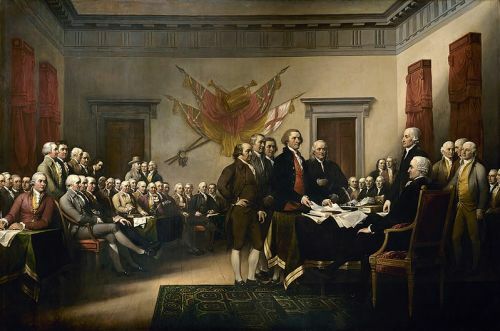THE French Revolution it was a revolutionary cycle that took place in France between 1789 and 1799 and that had as a practical result the end of the absolutism in the country. The French Revolution happened because of the dissatisfaction of the bourgeoisie with the privileges that the French aristocracy enjoyed and the people's dissatisfaction with their life of suffering, marked by poverty and hunger.
The French Revolution is one of the most important events in the history of mankind because it began the process of universalization of social rights and individual freedoms, provided for in the Declaration of Human Rights and Citizen. This revolution also paved the way for republicanism in Europe and for representative democracy. The French Revolution was inspired by the ideals of Enlightenment, that emerged in the 18th century.
Also access: Learn about the habits and practices of the absolutist aristocracy
Causes of the French Revolution
The French Revolution was the result of economic crisis, politics and Social that France lived in the late eighteenth century. This crisis in France was a direct consequence of a society marked by the typical inequality of the Old Regime, name by which absolutism in France was known. France at the end of the 18th century was ruled by Louis XVI.
French society was divided into three social classes:
Firststate: clergy
Secondstate: nobility
Thirdstate: remainder of the population that was not included in the other two states
Within this social organization, there was a very clear division, as clergy and nobility were classes that made up the aristocracy and that they enjoyed a series of privileges, such as exemption from certain taxes and the right to levy fees for their lands. The Third Estate, in turn, maintained all the burden of bearing the expenses of the French government. In addition, this class was extremely varied, as it included quite different groups, such as bourgeois and peasants.
France's great social inequality was the root cause of the upheaval that started the French Revolution. It is also important not to ignore the dissatisfaction of the bourgeoisie, who wanted to fight the privileges of the aristocracy as a way to prosper their business in the country. This converged on the revolution in 1789.
In the second half of the 18th century, France suffered the consequences of its economic backwardness (compared to England) in the development of the capitalism and the country's high expenditures. Attempts at economic reform took place in that century, but they failed, as they ran into resistance from the clergy and the nobility, who did not want to give up their privileges.
Unnecessary expenses were also one of the great evils of the country, especially those related to unnecessary wars, such as the american revolution. These factors heavily indebted the government and destroyed the French economy.
The economic crisis that took place in France directly impacted social relations in the country, as the nobility, trying to reduce the impact of the crisis on their lifestyle, increased the exploitation of the people. In this way, the peasants and the French middle class, in particular, were harmed. This happened because the nobility came to occupy government positions that were usually occupied by the middle class and because the taxes levied on the peasants increased.
This situation had a great impact, mainly on the income of the peasants, a group that was already in a delicate situation. The increase in taxes caused the peasants to give up an ever-increasing portion of their production, used primarily for subsistence. This made the peasants' lifestyle much worse in the twenty years before the French Revolution.
High French government spending was also a serious problem. In the late eighteenth century, France spent half of its annual budget on paying off state debts. One of the heaviest results of the economic crisis on the people was the rise in inflation and, consequently, the increase in the cost of living. As the situation in 1789 was delicate, the French king chose to summon the States General.
States General and the Fall of the Bastille
The States General were a kind of emergency assembly called by the French kings to make important decisions. The last States General had been convened more than 150 years ago. Although the French aristocracy hoped that measures would be taken, they wanted the assembly convened in 1789 to maintain aristocratic privileges.
The convocation of the States General coincided with a moment of great popular mobilization in Paris. This mobilization was a direct result of popular dissatisfaction with hunger, which had increased due to bad harvests of 1788. As a result, the price of food soared, leaving many unable to buy enough food.
With famine spreading across the country, the poorest people were thrown into rebellion or banditry. This situation made the popular layers of Paris see the States General as a way to improve the situation.
The decisions of the States General were carried out through a vote, in which each state was entitled to one vote. This mechanism allowed the union between nobility and clergy against the Third Estate and, thus, guaranteed the permanence of their privileges. The representatives of the Third Estate, in turn, suggested that the vote be individual, not by State. With that, the Third Estate would have the possibility of threatening the interests of the nobility and the clergy.
The proposal of the Third Estate by individual vote was rejected by the king, which motivated his people to break with the States General and form a National Constituent Assembly in order for a new Constitution to be drafted for France. Popular dissatisfaction took over the streets when the king opposed the Constitution and ordered the closure of the Constituent Assembly.
On July 14, 1789, the sans-culottes (Popular layers of Paris), enraged, decided to attack the Bastille, prison that housed political prisoners of absolutism. Although, at that time, the Bastille was almost deactivated, it remained a great symbol of absolutism. The Parisian population managed to take over the prison. This action is considered by historians as the great milestone that started the French Revolution.
Also access: See what were the influences of the French Revolution around the world
Phases of the French Revolution
After the fall of the Bastille, the revolutionary process spread throughout the country and lasted for a period of ten years. The revolution was only ended in France when Napoleon Bonaparte took power in the country through the Coup of the 18th of Brumaire. These ten years of extension of the French Revolution are divided into three phases:
National Constituent Assembly and Legislative Assembly (1789-1792)
Convention (1792-1795)
Directory (1795-1799)
National Constituent Assembly and Legislative Assembly
This is the phase of the French Revolution in which the action of the National Constituent Assembly and of the AssemblyLegislative. After FallgivesBastille, the revolution spread across the country and reached rural areas. The peasants feared that the aristocracy would react to the events happening in Paris and leave the population without food. With that, they went on the attack.
This reaction was called great fear and it took place between July and August 1789. In this episode, peasants began to invade the properties of aristocrats, carrying out looting and murdering the owners. In addition, they demanded the end of some taxes and wanted to be entitled to more food.
The constituents, fearing that the violence would increase, took some measures to contain the actions of the people. Thus, feudal privileges were abolished in France at the beginning of August and, later that month, the Declaration of Human and Citizen's Rights, one of the most important documents of the entire French Revolution. This statement established, in theory, that all men were equal before the law.
Popular violence and the changes that were taking place caused part of the French aristocracy to flee the country and go to other absolutist nations, such as Austria and Prussia. This aristocracy that fled France initiated counterrevolutionary efforts aimed at reimplanting absolutism in France.
French King Louis XVI and his wife, Marie Antoinette, also tried to flee France, but were recognized as they approached the Belgian border. After being captured, the French king was sent back to the Tuileries Palace, where he lived since 1789 – before that, the French king lived in the Palace of Versailles.
Other changes that took place during this period were due to the Civil Constitution of the Clergy, an attempt to bring the French clergy under government control. In 1791, the new Constitution of France was promulgated, which transformed the country into a monarchyconstitutional. After promulgation, the Constituent Assembly was transformed into a Legislative Assembly.
In this Assembly, two parties were consolidated, which were very important for the following years of the French Revolution: Girondin and Jacobins. You Girondin they sat to the right of the Assembly and had a more conservative posture in relation to the ongoing changes. already the Jacobins they were based on the left and shared a more reformist position, which defended the expansion of the reforms underway in the country.
During this period, rumors that Austrians and Prussians were organizing forces to invade France spread and caused the Assembly to issue a declaration of war against these two countries. The French fought this war with the National Guard, a troop that had sprung up in Paris at the beginning of the revolution and was led by the Marquis de la Fayette.
The beginning of the war created conditions for the radicalization of the revolution and led the population to support the Jacobins and the sans-culottes. War was declared in April 1792, and in September 1792 the Constitutional Monarchy in France fell. You sans-culottes announced the establishment of Republic in France.
Convention
With the Republic, the Legislative Assembly was transformed into Convention. The members of the Convention were chosen by universal male suffrage, and the French king, of course, was stripped of his office. At that moment, a new discussion took over French politics: the fate of Louis XVI.
The Jacobins defended that the king should be guillotined, as he was considered the main culprit for the evils facing France. The Girondins already defended the king's exile. Louis XVI's trial took a turn when an alleged safe was found in Tuileries with evidence of the king's involvement in the counterrevolution. The result of this was the execution of Louis XVI at the guillotine in January 1793.
This regicide inaugurated the phase of Horror in the revolution. The Jacobins seized power from France and, led by Maximilien Robespierre, initiated a phase of radicalization, which expanded the reforms in the country and persecuted all those who opposed it. In the Jacobin-controlled Republic, opponents were targeted by the Suspects Law, responsible for the death on the guillotine of 17 thousand people in 14 months|1|.
The Terror imposed by the Jacobins led the Girondins to organize and react with the Thermidorian reaction in 1794. With this event, the Jacobins were deprived of power, Robespierre was guillotined and the reformist agenda was replaced by a more conservative and liberal agenda. In 1795, the Convention was replaced by the Directory.
Directory
With the weakening of the Jacobins, the Girondins, at the head of the interests of the French upper bourgeoisie, drafted a new Constitution for France and reversed some measures. They also used the French army to repress all those who opposed the measures that were being implemented.
France remained in a wave of political, social and economic instability during the following years, which made the upper bourgeoisie defend the implantation of an authoritarian government presided over by a figure of strength. That figure was Napoleon Bonaparte, a general in the French army, famous at the time for leading the country's troops abroad.
Napoleon seized power in France in 1799 when he staged a coup that became known as the Brumaire 18 Coup. This marked the beginning of PNapoleonic period.
Also access: Learn about Napoleon Bonaparte's coronation in 1804
Consequences
The French Revolution was a milestone for humanity and caused a series of short-term and long-term changes in France and the world. Among the various consequences, some can be highlighted:
Universalization of social rights and individual freedoms
End of the privileges and remnants of feudalism in France
Beginning of the fall of absolutism in Europe
Separation of Legislative, Executive and Judicial Powers
Exercises
The French Revolution and the changes put into practice with the fall of absolutism in that country were influenced by:
a) Anarchism
b) Communism
c) Socialism
d) Enlightenment
e) Capitalism
LETTER D
The ideals of the French Revolution were inspired by the liberal ideals of the Enlightenment, an intellectual movement that emerged in Europe at the beginning of the 18th century. The Enlightenment defended ideas such as the equality of all men before the law and the fight against a privileged society. Another characteristic idea of the Enlightenment was the theory of three powers.
|1| HOBSBAWM, Eric. The Age of Revolutions: 1789-1848. Rio de Janeiro: Paz e Terra, 2014, p. 119.



